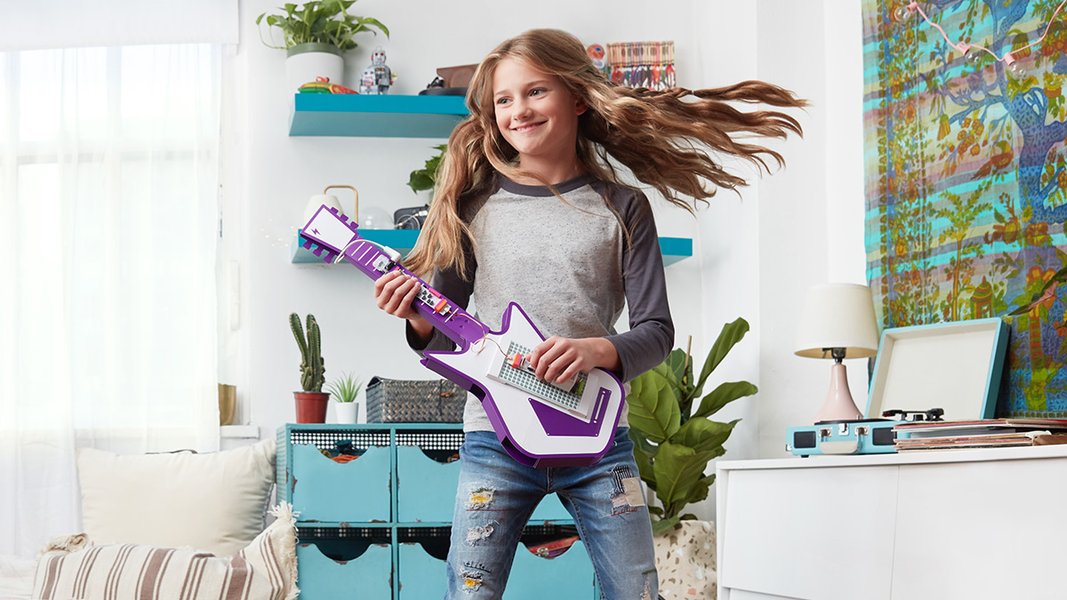Spring 2018 - Summer 2018
littleBits
Electronic Music Inventor Kit
The littleBits Electronic Music Inventor Kit allows kids to create their own instruments using littleBits circuits, paper templates, and craft materials.

How It Works
The littleBits Electronic Music Inveontor Kit is an electronic technology kit that encourages kids to reimagine the way we make music. Kids will learn about music history and will be challeged to create their own instrument. The kit comes with 10 littleBits, 5 paper templates, and a companion mobile/tablet app that walks them through the experience. Kids can build 5 separate projects including a "dance guitar" in which movement changes the pitch of the sound they create and a "magic guitar" that uses a proximity sensor to change the pitch of each note. Kids are then led through to a boss challenge in which they invent their own musical instrument using littleBits and craft materials.



My Role
I worked as a Product Designer on the Electronic Music Inventor kit and had the opportunity to develop the kit from start to finish. I was responsible for choosing the materials to include in the kit, designing paper templates to give a form to the inventions, mapping out a fun and engaging user journey, researching music history and facts to include in the kit, prototyping the app in HTML, CSS, and Javascript, and creating videos and assets to be used in the app. Throughout the process, I was able to user test the kit with over 30 children across NYC.

Process
I began this project working with a design strategist to research music history and come up with an exciting narrative around music that kids would enjoy. Througout our research, we found that western music really dominates music history in the US and found that our timeline consisted of almost only white men. We then decided to re-examine our approach and looked into music as resistance and its relationship to activism.

We then held many brainstorming sessions with people across the company to come up with fun projects that kids could build with music Bits. We then created a user journey that included projects and activities that kids could create with littleBits and cardboard templates.

Once we had our user experience down, I began prototyping cardboard templates that would come together to create a three-dimensional guitar. Initially I was using Flute E cardboard for this, but found through user testing that this type of cardboard didn't hold up very well after use. I then switched to a plastic-coated cardstock that was more pliable and easier to construct more complex pieces. I also worked with the ops team to QA the templates.




We then began designing a mobile/tablet app experience to accompany the physical kit. This experience followed the same basic format as the littleBits Base Inventor Kit. The app guides kids through all of the Electronic Music Inventor Kit builds with video instructions. We wanted to give kids an idea of the many ways each invention can be used, so we included play activities for each invention in the app. These activities include turning their guitar into a fart guitar, hosting a rap battle, and turning their backpack into a portable musical instrument. I then worked with an illustrator to create playful illustrations.




I also designed and developed an initial prototype of the app in HTML, CSS, and Javascript to use with kids in user testing sessions. The app included easy to use video instructions for each step of the building process. To make updating the app easier, I created a CSV file that housed all of the content for the app and coded the app to pull the content directly from the CSV file. This made it it much easier to iterate on the fly during user testing sessions.


Insights
The music theme keeps kids engaged



Kids enjoyed the music theme right from the beginning! Once they put each circuit together, they were incredibly engaged, giggling and making up fun songs.
Cardstock is more durable than corrugated cardboard

I initially began designing the guitar body with a corrugated cardboard. After a number of user tests with both corrugated cardboard and a plastic-coated cardstock, it became clear to me that the corrugated cardboard was harder for kids to use and was less durable than cardstock.